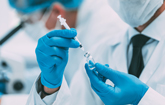ORLANDO, Fla., June 23, 2018 /PRNewswire-USNewswire/ -- A dual-hormone, artificial pancreas1 delivering rapid insulin and the drug pramlintide improved glucose control and reduced glucose variability in adults with type 1 diabetes (T1D) compared to an insulin-only, first-generation artificial pancreas, according to the study, "Insulin-plus-Pramlintide Artificial Pancreas in Type 1 Diabetes—Randomized Controlled Trial," presented today at the American Diabetes Association's® (ADA's) 78th Scientific Sessions® at the Orange County Convention Center Convention Center.
Managing T1D can be challenging, and maintaining healthy blood glucose levels is an integral part of preventing diabetes-related complications. Artificial pancreas systems work to automate blood-glucose management using a device that constantly monitors a person's blood glucose levels and then delivers insulin or a combination of insulin and other blood-glucose-lowering medications to the body.
Pramlintide is a synthetic, injectable analog of amylin, a hormone that is produced by the pancreas and released into the bloodstream after meals to help regulate blood glucose levels. Like insulin, amylin is completely absent in individuals with T1D. Apart from insulin analogs, pramlintide is the only drug to lower blood glucose in people with T1D and approved by the Food and Drug Administration (FDA) since insulin was certified in the early 1920s. Pramlintide was approved by the FDA in March 2005.
This Canadian study was a randomized, crossover comparison of a first-generation, rapid, insulin-only artificial pancreas (AP), and two novel, dual-hormone, artificial pancreas systems: 1) a rapid insulin and amylin (pramlintide) artificial pancreas (DAP), and 2) a regular insulin (Humulin R) and amylin artificial pancreas (R-DAP). The study enrolled 12 adults (7 males and 5 females, average age 43 years) with T1D and an average HbA1c level of 7.6 percent. All participants were studied three times in a clinical research facility for 24 hours (each participant was studied using each of the three artificial pancreas systems). During each 24-hour period, each participant consumed three meals and a bedtime snack. Insulin and amylin were delivered simultaneously in a basal-bolus manner using a dosing algorithm with a fixed ratio, mimicking a co-formulation.
The results showed that, on average, the DAP system improved the patients' blood glucose levels more than the AP system. The DAP had a longer timeframe that participants spent in the target blood glucose range of 3.9-10.0 mmol/L (85 percent), compared to the AP system (71 percent; p=.03). The DAP system also decreased glucose variability more (34 percent), compared to the AP system (25 percent; p=.01). Further, the DAP system produced a reduced, mean glucose level of 7.4 mmol/L compared to the AP system's reduction to 8.2 mmol/L (p=.07), without increasing the risk of hypoglycemia. Overnight, DAP and AP achieved similarly positive rates in the target blood glucose range of 3.9-7.8 mmol/L (77 percent and 71 percent, respectively). However, moderate nausea was reported by two participants using DAP compared to no reports of nausea using AP. There were no benefits associated with R-DAP compared to AP during either the day or night study periods.
"We were expecting some benefits with the insulin-plus-pramlintide artificial pancreas, yet we were impressed by both the extent of improvements and the lack of side effects, considering these benefits were achieved without increasing the risk of dangerous low-glucose levels," said lead study author Ahmad Haidar, PhD, assistant professor in the department of biomedical engineering, faculty of medicine at McGill University in Montreal, Canada. "This study shows that the first-generation, insulin-only artificial pancreas can be improved by delivering other hormones along with insulin, which will hopefully encourage the development of insulin-plus-pramlintide co-formulations."
To speak with Dr. Haidar, please contact the ADA Press Office on-site at the Orange County Convention Center on June 22 - 26, by phone at 407-685-4010 or by email at [email protected].
The American Diabetes Association's 78th Scientific Sessions, to be held June 22-26, 2018, at the Orange County Convention Center in Orlando, is the world's largest scientific meeting focused on diabetes research, prevention and care. During the five-day meeting, more than 16,000 health care professionals from around the world will have exclusive access to more than 3,000 original diabetes research presentations, participate in provocative and engaging exchanges with leading diabetes experts, and can earn Continuing Medical Education (CME) or Continuing Education (CE) credits for educational sessions. The program is grouped into eight theme areas: Acute and Chronic Complications; Behavioral Medicine, Clinical Nutrition, Education and Exercise; Clinical Diabetes/Therapeutics; Epidemiology/Genetics; Immunology/Transplantation; Insulin Action/Molecular Metabolism; Integrated Physiology/Obesity; and Islet Biology/Insulin Secretion. Felicia Hill-Briggs, PhD, ABPP, President of Health Care and Education, will deliver her address, "The American Diabetes Association in the Era of Health Care Transformation," on Saturday, June 23, and Jane E.B. Reusch, MD, President of Medicine and Science, will present her address, "24/7/365 – Lifetime with Diabetes," on Sunday, June 24. In total, the 2018 Scientific Sessions includes 375 oral presentations; 2,117 poster presentations, including 47 moderated poster discussions; and 297 published-only abstracts. Join the Scientific Sessions conversation on social media using #2018ADA.
About the American Diabetes Association
Nearly half of American adults have diabetes or prediabetes; more than 30 million adults and children have diabetes; and every 21 seconds, another individual is diagnosed with diabetes in the U.S. Founded in 1940, the American Diabetes Association (ADA) is the nation's leading voluntary health organization whose mission is to prevent and cure diabetes, and to improve the lives of all people affected by diabetes. The ADA drives discovery by funding research to treat, manage and prevent all types of diabetes, as well as to search for cures; raises voice to the urgency of the diabetes epidemic; and works to safeguard policies and programs that protect people with diabetes. In addition, the ADA supports people living with diabetes, those at risk of developing diabetes, and the health care professionals who serve them through information and programs that can improve health outcomes and quality of life. For more information, please call the ADA at 1-800-DIABETES (1-800-342-2383) or visit diabetes.org. Information from both of these sources is available in English and Spanish. Find us on Facebook (American Diabetes Association), Twitter (@AmDiabetesAssn) and Instagram (@AmDiabetesAssn).
247-OR Insulin-plus-Pramlintide Artificial Pancreas in Type 1 Diabetes—Randomized Controlled Trial
78th Scientific Sessions
News Briefing: Advances in Technology, Saturday, June 23, 11:30 a.m. ET
Session Title: Clinical Trials in Type 1 Diabetes
Session Type: Oral Presentations
Location: W308
Session Time: Sunday, June 24, 2018, 2:15 - 4:15 pm
Authors: AHMAD HAIDAR, MICHAEL TSOUKAS, SARAH TWARDY, NATALIA STRAUSS, JEAN FRANCOIS YALE, JOANNA RUTKOWSKI, ANNE BOSSY, EVELYNE PYTKA, HIEU T. NGUYEN, LAURENT LEGAULT, Montreal, QC, Canada, Pincourt, QC, Canada
We conducted a randomized crossover comparison between i) dual-hormone, rapid insulin and amylin (Pramlintide), artificial pancreas (DAP), ii) regular insulin (Humulin R) and amylin artificial pancreas (R-DAP), and iii) rapid insulin-alone artificial pancreas (AP) in 12 adults with type 1 diabetes. Insulin and amylin were delivered simultaneously, in a basal-bolus manner, using a novel dosing algorithm, with a fixed ratio (6 µg/u), mimicking a co-formulation. Participants were admitted three times for 24 hours and ingested three meals and a bedtime snack. Prior to closed-loop study, amylin was delivered for two weeks, and basal rates and carb ratios were optimized. Over the 24-hour study, DAP increased time spent in target range [3.9-10.0 mmol/L] compared to AP from 71% to 85% (P=0.03) and decreased glucose variability (CV) from 34% to 25% (P=0.01), without increasing the risk of hypoglycemia (P=NS). Overnight, DAP and AP achieved high and similar time in tight target range [3.9-7.8 mmol/L; 77%, 71%, P=NS]. Moderate nausea was reported by two participants (16%) on DAP compared to 0 (0%) on AP. There were no benefits associated with R-DAP compared to AP during day or night period. We conclude that a dual-hormone artificial pancreas delivering rapid insulin and amylin with fixed ratio improves glucose control and reduces glucose variability compared to insulin-alone, first-generation, artificial pancreas.
| Table 1. Comparisons between AP, DAP, and R-DAP (mean±SD) |
|||||
| Outcome |
AP |
DAP |
R-DAP |
P-value DAP |
P-value R-DAP |
| Time spent between 3.9 and 10.0 mmol/L during 24-hour study period (%) |
71 ± 19 |
85 ± 10 |
72 ± 16 |
0.03 |
0.86 |
| Mean glucose level during 24-hour study period (mmol/L) |
8.2 ± 1.3 |
7.4 ± 1.1 |
7.7 ± 0.8 |
0.07 |
0.38 |
| Coefficient of variance during 24-hour study period (%) |
34 ± 11 |
25 ± 6 |
35 ± 8 |
0.01 |
0.65 |
| Time spent between 3.9 and 10.0 mmol/L during daytime period (%) |
58 ± 26 |
78 ± 16 |
66 ± 21 |
0.02 |
0.58 |
| Mean glucose level during daytime period (mmol/L) |
9.1 ± 1.9 |
7.8 ± 1.5 |
8.4 ± 1.5 |
0.02 |
0.34 |
| Time spent between 3.9 and 7.8 mmol/L during overnight period (%) |
77 ± 20 |
71 ± 29 |
65 ± 19 |
0.47 |
0.16 |
| Mean glucose level during overnight period (mmol/L) |
6.6 ± 0.9 |
6.8 ± 0.9 |
6.6 ± 1.2 |
0.51 |
0.87 |
Author Disclosures: A. Haidar: Consultant; Self; Eli Lilly and Company. Research Support; Self; AgaMatrix, Medtronic MiniMed, Inc. M. Tsoukas: Speaker's Bureau; Self; Janssen Pharmaceuticals, Inc., Novo Nordisk Inc. Advisory Panel; Self; Sanofi. Speaker's Bureau; Self; Eli Lilly and Company. S. Twardy: None. N. Strauss: None. J. Yale: Advisory Panel; Self; Medtronic, Abbott. Speaker's Bureau; Self; Abbott. Advisory Panel; Self; AstraZeneca. Speaker's Bureau; Self; AstraZeneca. Advisory Panel; Self; Janssen Pharmaceuticals, Inc. Speaker's Bureau; Self; Janssen Pharmaceuticals, Inc. Advisory Panel; Self; Novo Nordisk Inc. Speaker's Bureau; Self; Novo Nordisk Inc. Advisory Panel; Self; Sanofi. Speaker's Bureau; Self; Sanofi. Advisory Panel; Self; Eli Lilly and Company. Speaker's Bureau; Self; Eli Lilly and Company. Advisory Panel; Self; Boehringer Ingelheim Pharmaceuticals, Inc. Speaker's Bureau; Self; Boehringer Ingelheim Pharmaceuticals, Inc. Advisory Panel; Self; Takeda Canada Inc. Speaker's Bureau; Self; Takeda Canada Inc. Advisory Panel; Self; Merck & Co., Inc. Speaker's Bureau; Self; Merck & Co., Inc., Bayer AG. Research Support; Self; Mylan, AstraZeneca, Bayer AG, Boehringer Ingelheim Pharmaceuticals, Inc., Eli Lilly and Company, Sanofi. J. Rutkowski: None. A. Bossy: Other Relationship; Self; Insulet Corporation, Medtronic. E. Pytka: Consultant; Self; Animas Corporation. H.T. Nguyen: None. L. Legault: Advisory Panel; Self; Insulet Corporation. Research Support; Self; Merck & Co., Inc., Sanofi. Advisory Panel; Self; Medtronic. Other Relationship; Self; Eli Lilly and Company.
______________________________________
1 An artificial pancreas is an external device or system of devices that mimics the glucose regulating function of a healthy pancreas. Such systems monitor glucose levels and automatically provide insulin, and potentially other blood-glucose stabilizing hormones, to the body. Current research does not intend to imply that this is a replacement for a pancreas.
Press Office in Orlando
June 22 - 26, 2018
407-685-4010
Contact:
Michelle Kirkwood
(703) 299-2053
[email protected]
SOURCE American Diabetes Association
Related Links
WANT YOUR COMPANY'S NEWS FEATURED ON PRNEWSWIRE.COM?
Newsrooms &
Influencers
Digital Media
Outlets
Journalists
Opted In






Share this article